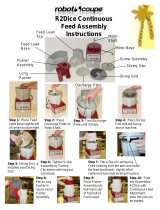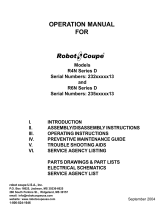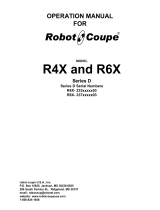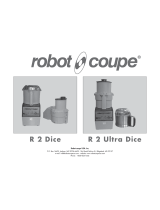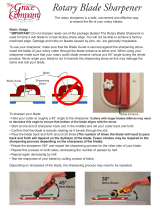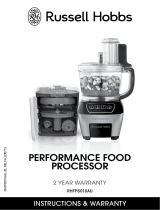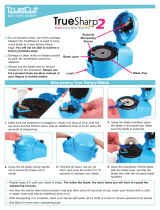Page is loading ...

R6VN series D Operation Manual
MODEL
robot coupe U.S.A., Inc.
P.O. Box 16625, Jackson, MS 39236-6625
280 South Perkins St., Ridgeland, MS 39157
email: [email protected]
website: www.robotcoupeusa.com
1-800-824-1646
R6VN R6VN
R6VN R6VN
R6VN
SERIES SERIES
SERIES SERIES
SERIES
DD
DD
D
I. INTRODUCTION
II. ASSEMBLY/DISASSEMBLY INSTRUCTIONS
III. OPERATING INSTRUCTIONS
IV. PREVENTIVE MAINTENANCE GUIDE
V. TROUBLE SHOOTING AIDS
VI. SERVICE AGENCY LISTING
OPERATION MANUAL
FOR

R6VN series D Operation Manual

R6VN series D Operation Manual
Page 1
I. INTRODUCTION
The Robot Coupe commercial food processor performs a host of culinary feats. It is specifically designed for
high speed and quality vegetable processing. The Robot Coupe also provides a wealth of safety and operat-
ing features to make volume food preparation a pleasure rather than a chore.
The operators’ manual is designed to guide the user through the simple steps of use for a safe, long life
utilization.
The manual should be read completely by the operator before
any attempt is made to use the machine. Also, the manual
should be referred to any time there is a question on operation.
Your Robot Coupe comes with sharp cutting blades and or,
cutting “plates”. Always handle with safety in mind. We sug-
gest that a pair of cutting gloves be worn when handling any
plates or blades. Also, never put your fingers inside of the
bowl or feed lead openings.
If the machine fails to operate as described in this manual, or
if the machine malfunctions in any way, remove the machine
from use and have it serviced. Additionally, discard all food
processed at the time of the malfunction.

R6VN series D Operation Manual
Page 2
II. ASSEMBLY / DISASSEMBLY INSTRUCTIONS
A. Assembling the Continuous Feed Attachment
STEP #1 Unplug the machine. Place the motor base assembly at a comfortable height on a sturdy
work surface. Remove the plastic discharge plate from inside the continuous feed attachment. Place the
continuous feed attachment on the motor base with the release button at front center of the motor base
assembly. Rotate the attachment counterclockwise until it locks into place with a snap action. When the
attachment is in the proper position, it should be level with the top surface of the motor base assembly.
NOTE: The machine will not operate correctly unless the continuous feed attachment is fully seated and
secured in place.
STEP #2 Place the discharge plate on the motor shaft with the appropriate side up. Use the side
with the small straight fins for all julienne cuts or other delicate cuts. The large finned side may be used for
dicing or shredding. The product will not exit the machine without the discharge plate.
STEP #3 IF YOU ARE PREPARING TO SLICE OR JULIENNE: Place the plate of your choice
on the motor shaft and turn clockwise until it drops into place and is fully seated. The top of the plate
should be just above the surface of the continuous feed attachment.

R6VN series D Operation Manual
Page 3
Warning Wear cutting gloves when handling the cutting plates or the
blade.
STEP #3 IF YOU ARE PREPARING TO SLICE OR JULIENNE: Place the plate of your choice on
the motor shaft and turn clockwise until it drops into place and is fully seated. The top of the plate should be
just above the surface of the continuous feed attachment.
STEP #4 IF YOU ARE PREPARING TO DICE OR USE A FRENCH FRY COMBINATION: NOTE:
The recessed rim on the continuous feed attachment must be free from product and clean so the grid can be
firmly seated. The discharge plate must be in the machine or the product will not exit.
With the tab on the plastic grid aligned with the cutout in the Continuous Feed Attachment, place the plastic
grid onto the recessed rim of the Continuous Feed Attachment. Put the appropriate slicing plate on top of the
dicing grid with the stem of the plate DOWN. NOTE: Only those slicing plates designed with a locking
“L” shape slot can be used in conjunction with a dicing grid. Never attempt to use a “regular” slicing
plate (1mm, 2mm, 3mm) in conjunction with a dicing grid as it may cause damage to the continuous
feed lead and/or the pushers. Rotate the plate until the cutout in the stem drops into place on the motor
shaft pin. Continue rotating the plate a full turn. If rubbing occurs DO NOT PROCEED-call your service
agency.
STEP #5 Place the continuous feed lead on the continuous feed attachment and secure in place with
the holding pin. The lead should fit flush on the continuous feed attachment.
B. Disassembly of the continuous feed attachment
STEP #1 Turn the unit off and unplug the power cord from the wall outlet.
Step #2 Pull out the hinge pin from continuous feed lead and lift the latch at upper right front of
machine. Remove the continuous feed lead.

R6VN series D Operation Manual
Page 4
Step #3 Remove the cutting plate. Wear cutting gloves. Rotate the plate slightly counterclock-
wise, then lift up and off of the motor shaft. Remove the dicing or French fry grid (if any) then, lift out the
plastic discharge plate.
Step #4 Press the release button on the continuous feed attachment and at the same time turn the
continuous feed clockwise. The continuous feed releases and can be lifted off over the motor shaft.
C. Assembling the Cutter Bowl Attachment
D. Disassembly of the Cutter Bowl Attachment.
The blade should be disassembled and cleaned after each day’s use.
STEP #1 Turn the machine OFF and UNPLUG the power cord from the wall socket.
STEP #2 Rotate the bowl lid clockwise and lift off.
STEP #3 Firmly grasp the top of the blade assembly and lift up and off of the motor shaft.
STEP #4 Locate the release trigger on the lower back portion of the bowl handle. Pull the trigger
and, at the same time, turn the bowl clockwise and lift free.

R6VN series D Operation Manual
E. Blade Assembly/Disassembly
III. OPERATING INSTRUCTIONS
A. GENERAL OPERATION INSTRUCTIONS
The R6VN is a state-of-the-art processor. It utilizes state-of-the-art electronics to control and monitor the
motor speed. This unit offers a infinitely variable speed ranging from 370 to 3000 revolutions per minute
(RPM). This wide range of speed is used to match the product to be processed to the best cutting speed of
the cutting blades. There are a few general rules which apply to speed control.
NOTE: This machine is equipped with manual reset thermal overload protection. If the machine is over-
loaded or run too long under heavy load conditions then the overload will trip. If this occurs, first remove the
bowl and reduce the amount of food being processed. The reset button is located on the bottom right corner
of the motor base. Press the button in to reset the overload protector.
BOWL ATTACHMENT: Generally, the medium high and high speeds will be used for the bowl operation.
Medium high speed (1725 RPM) is used to chop products, and mix and knead dough and pastry. Also, the
medium high speed is used as a first stage of reduction for a puree, sauce or other homogeneous mixture.
As a general rule, the bowl should be operated using the medium high speed. Use higher speeds after the
product has been reduced or mixed initially on the medium high speed.
Page 5

R6VN series D Operation Manual
Some applications, such as mixing dry powders, may require the use of lower speeds with the bowl attach-
ments. However, a controlled chop and good puree will not be accomplished at the lower speeds with the
bowl attachment.
The cutter bowl attachment is used for grinding, pureeing, blending, mixing, of ingredients.
With the power switch off and the bowl and blade secured in place (per previous instructions) you are now
ready to add product to the bowl. There are two ways to run your machine. Chop by using a quick start/stop
action or running continuously for a fine chop or puree. Most operations start by using the medium high
speed (1725 RPM). Use this speed for chopping and general mixing requirements. Medium high is also
used to initially reduce meats and vegetables prior to turning the machine to high speed. Some dough
applications, like pie crust work best around 1100 RPM.
1. TO CHOP: To achieve a chopped consistency for vegetables, meats, cheese, etc.. Fill the bowl
2/3 to 3/4 full with chunks no larger than 1 to 2 inch square (1/4 full for meats, cheeses and very dense
products). Start the machine allowing the machine to come up to speed then quickly press the stop switch.
Continue this process until the desired consistency is reached. If the motor stalls, reduce the amount of
product in the bowl.
2. TO PUREE OR FINE CHOP: For a fine puree , emulsification or fine chop fill the bowl 2/3 to
3/4 full with chunks no larger than 1 to 2 inches square. With the speed set at medium high, turn the machine
on and allow to run a short time until the product is finely chopped, then increase to high speed to finish.
High speed is only used to finish a product after it has been reduced at a lower speed. Some purees may
require the addition of a liquid to obtain the correct consistency.
3. TO CHOP HARD CHEESE: Place uniform chunks of chilled cheese into the bowl and quickly
press the on, then the off buttons. For powdered cheese, do the same, until the cheese is about pea size
then allow the motor to run continuously until you have a fine powder.
4. TO CHOP ONIONS, CELERY, CABBAGE, ETC. Quarter onions, and cut other vegetables
into 2 to 3 inch chunks. Place the product into the bowl up to 3/4 full and pulse the unit until you reach the
desired consistency.
CAUTION: If you turn the unit on and let it run too long the bottom blade will puree the ingredients and the
top blade will be of little value leaving an uneven consistency.
5. TO PUREE OR MIX: To puree, make sauces, or to mix and blend, place the ingredients into the
bowl, turn the unit on and allow to run continuously.
DO NOT allow the machine to run unattended.
Page 6

R6VN series D Operation Manual
CONTINUOUS FEED ATTACHMENT:
This attachment is always used with speeds less than 1725
RPM (medium high). Running the machine with this attachment at speeds higher than me-
dium high (1725 RPM) should not be done under any circumstances. The continuous feed attachment
should only be run at speeds approaching the medium high setting during a shredding operation such as
shredding carrots or cabbage. Running cheese at the medium high speed will produce poor results. The
dicing operation should never be run on speeds higher than medium. As a general rule, you should limit the
use of the continuous feed attachment to the low and medium speeds.
Running the machine with this attachment at speeds higher
than medium high speed can cause damage to the machine.
Damage caused by running the machine at the higher speeds
is not covered under warranty.
As indicated on the front data plate, use the low speed (370 RPM) for soft products such as tomatoes, kiwi,
strawberries, bananas, etc. The softer products cut better at the lower speeds. Additionally, most dicing and
some julienne operations perform best at the lower speeds. The medium speed (850 RPM) is used for all
other products. Slicing, shredding, and julienne should be performed using the medium speed. Trial runs
with your particular product at different speeds should be noted for future use. Keep in mind
that you should not run the continuous feed attachment at
speeds higher than the medium high speed.
NEVER ATTEMPT TO RUN FROZEN PRODUCTS THROUGH THE
CONTINUOUS FEED ATTACHMENT.
A. Operation of the Continuous Feed Attachment
The Continuous Feed Attachment will perform the functions of slicing, shredding, dicing, and julienne. Be-
cause of the speed of operation, vegetable preparation, entry port loading, and availability of a receptacle or
“catch pan”, should be determined before the machine is turned on.
Vegetable preparation will be required to assure that the produce will fit a port opening. Additionally, one may
or may not choose to core or peel some products. Port selection should be made depending upon the
product to be processed. As an example good consistency of small round produce (carrots, cucumbers,
etc.) necessitates use of the small entry port to allow operator control. Use of the larger port for this type of
produce may result in undesired finished product, e.g. slicing with the grain. In general, more control of the
processing operation can be obtained by filling the selected entry port and placing the pusher in position
before turning the machine on.
Adherence to certain operational techniques will also enhance the processing operation. For instance, a
constant pressure with the pusher upon the produce will yield a consistent output. Application of more pres-
sure will increase the thickness of the product e.g. thicker slice, while reduction in pressure will result in a
“finer” product. If no pressure is applied at all and the produce is permitted to bounce around , an inconsistent
product will result. When the pusher has settled fully in the entry port, turn the power OFF and reload the
entry port for a repeat process.
Page 7

R6VN series D Operation Manual
THE UNIT SHOULD BE IN THE OFF POSITION EXCEPT WHEN
PROCESSING IS UNDERWAY
. It is recommended that the machine be operated on a
50% duty cycle. This is easily accomplished since the preparation time (cleaning, coring, peeling, and
loading) takes longer than the processing time. This will increase the life of your machine.
DO NOT remove the continuous feed lead when the motor is
running. Wait until the motor has come to a full stop.
DO NOT put anything other than food products inside the entry
ports.
DO NOT attempt to run frozen products through the cutting
plates.
(1) Slicing Operation: The vegetables must be prepared so that they will fit into the proper entry port.
Produce such as carrots, cucumbers, etc. should be “squared” at both ends. This will provide a consistent
slice throughout the whole product. With cabbage, lettuce or any product that has an undesirable core, the
core should be removed. Medium size heads of lettuce or cabbage may be halved to fit in the large entry port.
It is also suggested that the rounded half be “squared” to permit a consistent cut. The “rounded” portion can
be dropped into the port at the end with no pressure applied, it will normally come forth “finely” sliced as the
rest. Larger heads of cabbage or lettuce may be more effectively processed if they are halved and then cut
into thirds. When the preparation has been accomplished, fill the selected entry port, place the pusher in
position, and turn the machine on and observe the results.
(2) Grating Operation: Again, vegetable preparation should be done to allow insertion of the produce into
the entry port. Consideration should be given to which port is desired. As an example, placement of carrots
horizontally in the large port will result in a long grated product, while vertical insertion in the smaller port will
result in a short grated product. It is recommended that “cold” cheese be used when grated cheese is
desired, otherwise a gumminess may result. A fine coating of cornstarch applied to the cheese before
grating will aid in keeping the finished product separate. The cornstarch will not be visible and is tasteless.
Grating cheese is one of the most trying operations and because of the nature of the product may cause
overheating of the motor if not grated in the recommended manner. It is recommended that a slight pulsating
pressure be applied with the pusher while grating, alternating slight pressure then no pressure and continu-
ing in this manner until the block of cheese is completely grated. Typically, twenty (20) pounds of cheese can
be grated in approximately five minutes. It is recommended that the cheese be prepared to fit the opening in
increments to permit a rest between grating operations. After thirty (30) continuous minutes of cheese
grating allow your machine to cool.
(3) Dicing Operation: The dicing operation requires that product be sliced both horizontally and vertically.
The smaller the dice required, the more difficult the cut is to achieve. Soft or juicy produce will tend to mush
if the dice is too small or the produce is too soft. Cheese and meat represent the opposite extreme. Because
of the consistency of cheese and meat, it is recommended that this product not be diced. Damage could
occur to the blades and/or the motor and will not be covered under warranty.
During the dicing operation, attention should be given to the finished product. A visible change in the product
will occur when the dicing grid requires cleaning. A stiff bristle brush can be very effective in forcing product
through the grid.
Page 8

R6VN series D Operation Manual
(4) Julienne Operation: Insertion of the product to be cut must be horizontal if a long “stick” is to be
achieved, e.g. julienne zucchini for saute. Vertical insertion will result in finely chopped products, e.g. celery.
A finely chopped onion product may also be obtained with this operation by quartering the food and letting it
gravity feed.
Never attempt to julienne meats or cheeses.
B. PLATE UTILIZATION:
The standard machine comes with two (2) plates. Check your most current price list for which plates are
included as standard. User applications may require additional plates. The Robot Coupe processor will
perform a variety of functions: slicing, grating, dicing, and julienne. There are a total of 34 different plates
available to perform these functions (see below). The number and type of plates required will vary, depend-
ing upon the planned utilization.
8 slicing plates
8 grating plates
5 dicing plates
7 julienne plates
3 wave slicing plates
3 straight French fry plate combinations
The eight (8) slicing plates range form 1mm (approx. 1/64") to 14mm (approx. 1/2"):
Part Number MM Slicing Inches (Approx.)
C444SA 1mm 1/32"
C445SA 2mm 5/64"
C446SA 3mm 1/8"
C477SA 4mm 5/32"
C437SA 5mm 3/16"
C436SA 8mm 5/16"
C435SA 10mm 3/8"
C434SA 14mm 9/16"
The C444SA (1/32") slicing plate offers a very fine cut. A possible use for such a fine cut is the preparation
of Japanese style vegetables. Typically these products (such as carrots or celery) will be placed in the
pusher horizontally to obtain a long thin product.
The C445SA (5/64") slicing plate finds a variety of applications. Cabbage may be sliced with this plate for
New York Style Cole Slaw. Carrot curls which adorn many dishes can be achieved with this slicer. The
carrot slices should be dropped into cold water to permit curling. A nice carrot coin for salads can also be
obtained.
The C446SA (1/8") slicing plate is ideal for salad bars ie., cucumber slices, carrot “coins” (vertically sliced
carrots). Lettuce sliced by this plate is readily used for sandwiches, tacos, etc.
The C477SA (5/32") and C437SA (3/16") slicing plates are also ideal for salad bar use, for the stock pot
where thicker “man” size cuts are desired. This blade is excellent also for orange or lemon slices as well as
tomatoes, where a nice smooth surface is desired. NOTE: You can not slice meats or cheeses on any food
processor.
The C434SA, C435SA, C436SA slicing plates are used in conjunction with the dicing grids. In addition
thicker slices can be obtained for use in soups and stews. The C434SA (9/16") slicer also provides an
excellent cut of lettuce for use in a salad.
Page 9

R6VN series D Operation Manual
There are eight grating plates available for use with the R6:
Part Number Size MM Inches (Approx.)
C495GPA X-Fine
C452GPA Hard cheese
C494GPA 1.5 mm 1/16"
C451GPA 2 mm 5/64"
C450GPA 3 mm 1/8"
C453GPA 5 mm 3/16"
C478GPA 7 mm 5/16"
C433GPA 9 mm 3/8"
The C452GPA hard cheese grating plate is designed specifically to grate Parmesan or Romano cheese.
CAUTION: Softer cheese will tend to gum up the plate. The grated product is very fine. This plate can be
used for making cracker or cookie crumbs. Dried bread crumbs can be obtained CAUTION: the moisture
in fresh bread will cause clogging and poor results.
Use of either the C451GPA, C450GPA, or C453GPA, fine, medium, and coarse grating plates are much
dependent upon personal choice and specific application. The medium and coarse grating plates offer a
quality grated product with cheese, carrots, cabbage for cole slaw, etc.
A diced product requires two actions. First, a horizontal slice is made and then this slice is forced by the
machine through the dicing grid to obtain a vertical cut. This results in a cubed product. The dimensions of
this cube are varied via the selection of the slicing plate and dicing grid.
The 5mm dicing combination is generally used for potatoes and squash because of its small size.
The 8mm smaller dicing combinations can be used for finely diced carrots, celery, etc. and readily used in
soups or stews. The larger (14 mm or greater) dicing combinations work well with fruits such as apples,
pears, pineapple, etc.
Page 10
dicing
grid 5x5 mm 8x8 mm 10x10 mm 14x14 mm 20x20 mm 25x25 mm
Plate
5 mm 28110
8 mm 28111
10 mm 28112
14 mm 28113
20 mm 28114
25 mm 28115
The shaded areas indicate combinations that can be used.

R6VN series D Operation Manual
When dicing tomatoes, green peppers, onions, or celery always insure that the product is introduced into the
machine so that the slicing plate will be slicing across the grain of the vegetable.
CAUTION: The softer the produce, the less acceptable will be the finished product.
When dicing tomatoes, green peppers, onions, or celery always insure that the product is introduced into the
machine so that the slicing plate will be slicing across the grain of the vegetable.
After a time of use, the dicing grid will require cleaning. A visible difference in the finished product will occur
when cleaning is required. The best way to clean the grid is: remove the slicing plate, take a stiff bristle
brush and force the product that is on the grid to go through.
There are seven Julienne plates available:
C460JA 2 x 2 mm (5/64")
C483JA 2 x 4 mm (5/64" x 5/32")
C484JA 2 x 6 mm (5/64" x 1/4")
C486JA 2 x 8 mm (5/64" x 5/16")
C462JA 4 x 4 mm (5/32")
C438JA 6 x 6 mm (1/4")
C466JA 8 x 8 mm (5/16")
Products such as julienne carrots, chopped celery and finely chopped onions are obtainable
as well as julienned celery roots.
DO NOT ATTEMPT TO JULIENNE MEATS OR CHEESES!
There are three wave slicing plates:
Part Number MM Slicing Inches (Approx.)
C445W 2mm Waved 5/64"
C446W 3mm Waved 1/8"
C464W 5mm Waved 3/16"
The waved slicing plates work just like the straight slicing plates, except that the product has waved or
ruffled sides. This can be an attractive alternative to the flat slices that are so prevalent on salad bars. By
adding a waved plate you can dramatically alter the presentation of the food. As with the straight slicing
plates remember that harder foods slice best when cut thinner and softer foods slice best when cut thicker.
Page 11

R6VN series D Operation Manual
Page 12
C. Operation of the Cutter Bowl Attachment
The cutter bowl attachment is used for chopping, grinding, pureeing, blending, mixing, and kneading of
ingredients required in most every recipe.
With the power switch off and the bowl and blade secured in place (per previous instructions) you are now
ready to add product to the bowl. Place the product in the bowl not over 3/4 full and rotate the cover to
secure it in place. The bowl is operated using a quick start - stop action. Quickly start and stop the motor by
alternately pressing the on and off switches. The reason for this is that you want the lower blade to pick up
the product and throw it into the air allowing the top blade to chop the product. Control and consistency can
be better achieved in this manner. Remember, if you start with a consistent product your end product will
also be consistent.
TO CHOP MEAT: Place chunks of meat approximately 1 to 2 inches square in the bowl. Fill
approximately 1/3 to 1/2 full (no more that 2 1/2lbs.) Rotate the lid locking it in place, quickly start and stop
the motor using the on/off switches. Repeat this process until product is the desired consistency.
TO CHOP HARD CHEESE: Place chunks of well chilled cheese into the bowl (not over 2 1/2
pounds). With the lid locked in place quickly start and stop the motor. Continue this process until you have
reached the desired consistency. For powdered cheese, simply proceed as above until the particles in the
bowl are about pea size then start the unit and allow the blades to run continuously until you have a fine
powder.
TO CHOP ONIONS, CELERY, CABBAGE, CARROTS. ETC. Quarter onions, and cut other veg-
etables into 2 to 3 inch pieces. Proceed using a quick start - stop action until the desired consistency is
achieved. CAUTION: If you turn the machine on with vegetables in it and let it run too long a period of time,
the bottom blade will puree the ingredients and the top blade will be of little value leaving a very uneven
consistency.
TO PUREE OR MIX: To puree tomatoes, make sauces, or to mix and blend, place the ingredients
in the bowl, turn the unit on and allow it to run continuously until the product is rendered to the desired
consistency.
TO MAKE MAYONNAISE: Place in the bowl 6 eggs, 3 tsp. of salt, 3 tsp. of sugar, 2/3 tsp. of dry
mustard, a pinch of white pepper, and a pinch of red pepper. Turn the unit on. Begin adding 2 qts. of oil
pouring very slowly through the top allowing the stream of oil to fall on the top of the cutter blade. When you
have added 1/2 of the oil, pour in 4 oz. of vinegar and the balance of the oil. After all of the oil has been
added let the machine run for 20 seconds longer. The mayonnaise is now homogenized.
TO MAKE BREAD CRUMBS: Place torn fresh or dried bread in the bowl, and quickly start and
stop the unit. Continue this process until you reach the desired consistency or allow the unit to run continu-
ously for finely powered bread crumbs used in stuffing mix.
The blades are sharp. KEEP FINGERS AND HANDS AWAY
FROM BLADES. Always allow the blades to come to a com-
plete stop before removing the lid.

R6VN series D Operation Manual
D. GENERAL HINTS:
1. Be sure your Robot Coupe is properly assembled before using.
2. Always insure blade and attachment are tightly in place.
3. Do not fill the cutter bowl over 3/4 full.
4. Learn to operate the cutter bowl using a start - stop motion so the consistency of the prepare
product can be controlled. Remember it is important to start with uniform pieces for uniform
results.
5. Wash the bowl, blade and cover after every use. Do not store food in the bowl.
6. If the motor does not start when the switch is on and lid is in position, disengage the lid (ma-
chine is now off) and check to see if the bowl attachment is locked in place. If okay,
unplug the unit and see if any food is jamming the blade.
7. If the machine malfunctions for any reason, discard any food being processed at that time.
IV. PREVENTIVE MAINTENANCE/TROUBLE SHOOTING AIDS:
The Robot Coupe has been designed to provide maximum trouble free performance. Adherence to the
assembly and operating instructions will further assure good performance. Additionally, if simple common
sense rules are applied to the unit, a long life utilization will be achieved.
(1) Care: While the Robot Coupe is a ruggedly constructed machine, overall handling should be accom-
plished with a sense of use rather than abuse. The continuous feed attachment and the motor housing are
made of rugged cast aluminum and will yield a long life if not maltreated. While the machine is reasonably
portable, care should be taken not to drop it. Remove the continuous feed and any plates or other attach-
ments before relocating the machine. Your Robot Coupe should never be picked up by the continuous feed
lead, the bowl or the cord. Always lift from the bottom of the motor base assembly. Care should be exer-
cised in relocating it. Equal caution should be exercised in handling all of the parts to assure they are not
subject to undue force.
(2) Cleaning: Proper cleaning of the machine is one of the MOST IMPORTANT preventive maintenance
measures the user can employ. The high acid content of food can cause harm to electrical parts contained
within the housing. Although these elements are isolated from the outside through seals, vegetable juices
will tend to seep. If vegetable juices are permitted to collect on the machine over periods of use, erosion of
the seals can occur. It is recommended that the machine be cleaned after each operational use, and
minimally once per day.
The blade assembly (R6N only) should be taken completely apart and washed after each days use for
sanitary reasons, and also to prevent the parts from becoming jammed or “freezing up”. Follow the previous
assembly/disassembly instructions carefully and wear cutting gloves when handling the cutting blades.
Correct cleaning procedures are required to assure that damage is not inflicted in the cleaning process. The
motor support/base assembly contains the motor and electrical components.
DO NOT IMMERSE THE MOTOR BASE ASSEMBLY IN WATER.
While the continuous feed lead, pushers and plates are dishwater safe , some additional cleaning may be
required. Cleaning of the plates should be accomplished with care to help prevent cuts. A stiff bristle brush
will be effective in knocking the food out of the crevices.
Cleaning of the motor/base assembly must be done with care. First, unplug the unit - a sponging with a
soluble detergent is acceptable, making sure the water is not permitted to penetrate the seals. Clean around
the seals with a small brush, taking care to remove all food. Do not forget to clean the motor shaft with a
small brush.
Page 13

R6VN series D Operation Manual
Read the label for the dish machine detergent you are using to determine if it is safe for soft metals. If you
can not determine if it is safe for soft metals, then contact your supplier for this information. Many other
cleaning detergents can also cause corrosion of soft metals.
Do not wash the aluminum parts of this machine using a nonmetal safe detergent either in a dish machine or
pot sink! Clean the aluminum feed attachment using only soft metal safe detergents.
While the continuous feed lead, pushers and plates are dishwasher safe if used with a metal safe detergent,
some additional cleaning may be required. Cleaning of the plates should be accomplished with care to help
prevent cuts. A stiff bristle brush will be effective in knocking the food out of the crevices.
Wear cut resistant gloves when cleaning the blade or the cut-
ting plates.
(3) Preventive Maintenance: In addition to cleaning the seals, an examination should be made periodically
to assure that a seal against food is being maintained. With proper care, and depending on use, the seals
should last for a year or more. However, they can and should be replaced when wear or erosion is noted. It
is recommended that the seals be replaced by an authorized repair agency.
Good operational performance is obtained when the blades are sharp. Continued use can dull the
blades. All of the slicing and grating plates are made so that the blades can be replaced when they
become dull. The cutter bowl blade an the blades on the slicing plates can be sharpened. Instructions
are included in the back of this manual. Always store the plates in the plate holders. Additional plate
holders can be obtained from your food service distributor.
In general, the best preventive measure that can be applied is close adherence to the assembly and operator’s
instructions along with common sense. Make sure the continuous feed assembly is fitted on flush before
operating the machine.
Your Robot Coupe is a piece of kitchen equipment and like all other kitchen equipment, extreme care and
caution should be used when operating. Although training requirements are minimal, only responsible
individuals familiar with this operation manual should be allowed to operate your Robot Coupe.
DO NOT remove the attachments from the base when the motor is running.
DO NOT remove the continuous feed lead attachment when the motor is
running. Wait until the motor has come to a full stop.
DO NOT overload the bowl with food.
DO NOT put your hands, utensils, or anything other than food product into
the feed openings or the exit port.
DO NOT immerse the motor base in water.
DO NOT allow the machine to run unattended.
DO NOT operate the machine unless all parts including the feet are properly
attached.
Page 14

R6VN series D Operation Manual
Page 15
DO NOT use excessive force with the pusher.
DO NOT leave the machine ON when not processing food.
DO NOT lift the machine by anything other than the motor base.
DO NOT operate a machine unless it is completely assembled and all parts
V. Trouble Shooting Aids
The following section indicates potential problems and the probable solution which should be implemented
by users. Problems which extend beyond these will require an experienced serviceman. A list of
authorized service agencies is supplied.
A. Unit does not start.
1. Are all the attachments tightly in place? Be sure the continuous feed lead is flush with the
continuous feed attachment. Bowl: Is the long bowl lid tab fully in place over the handle. Try
again.
2. Press the OFF button and unplug the machine.
3. Remove continuous feed lead.
4. Remove any product from inside continuous feed lead and attachment.
5. Is there any product jamming the plate? Wear cut-resistant gloves when removing a jam.
6. Try another outlet.
B. Continuous feed lead will not fit flush with motor base.
1. Processing plate is not in it’s proper position.
2. Rim of plate should be slightly above the upper edge of continuous feed attachment.
C. Unit stops running.
1. Press the Off button.
2. Unplug.
3. Follow A. above and try again.
D. If unit does not operate after following A above
1. Check outlet for current (breaker for fuse).
2. Try unit again.
3. Call local service agency.
E. Unit starts to spark or smoke.
1. Turn unit off, unplug it, call local authorized service agency.
F. Unit Makes grinding noise.
1. Turn off unit, disassemble, check continuous feed lead and processing plate to see if they
have been rubbing together.
2. If this was the case the processing plate was not fully seated.
Discard any food processed. Check
for food particles inside stem of processing plate. Replace plate insuring that processing plate is
fully seated. Make sure there are not food particles on the motor shaft.

R6VN series D Operation Manual
G. Food is going into machine, but not coming out.
1. Discharge Plate is not in unit.
H. Cucumbers coming out with torn skins.
1. Blade is dull on plate and must be changed. NOTE: cucumber condition before processing should
be considered.
2. Make sure the small “vane” side of the discharge plate is up.
In general, the best preventive measure that can be applied is close adherence to the assembly and operator’s
instructions along with common sense. Make sure the continuous feed assembly is fitted on flush before
operating the machine.
A. Unit does not start.
1. Are all the attachments tightly in place? Be sure the continuous feed lead is flush with the
continuous feed attachment. Bowl: Is the long bowl lid tab fully in place over the handle. Try again.
2. Press the OFF button and unplug.
3. Remove continuous feed lead.
4. Remove any product from inside continuous feed lead and attachment.
5. Is there any product jamming the plate? If so, press the OFF button and unplug the machine before
removing jam.
6. Try another outlet.
B. Continuous feed lead will not fit flush with motor base.
1. Processing plate is not in it’s proper position.
2. Rim of plate should be slightly above the upper edge of continuous feed attachment.
C. Unit stops running during (while processing).
1. Turn unit Off.
2. Unplug.
3. Follow A. above and try again.
D. If unit does not operate after following A above
1. Check outlet for current (breaker for fuse).
2. Try unit again.
3. Call local service agency.
E. Unit starts to spark or smoke.
1. Turn unit off, unplug it, call local authorized service agency.
VI. SERVICING OF YOUR ROBOT COUPE
Your Robot Coupe has a one year limited warranty against defects in parts and workmanship. Should the
unit require service, check with your distributor to see where local service is available. If not or if you wish
your unit to be serviced at the factory, call for a return merchandise authorization (RMA) number, and upon
receipt of same, ship it PREPAID and insured to our factory address.
Robot Coupe USA, Inc. Service Dept.
Phone: 1-800-824-1646
601-898-8411
Page 16

R6VN series D Operation Manual
Page 17
Sharpening The Blade on The Cutting Plate
ALWAYS WEAR CUTTING GLOVES WHEN HANDLING THE
BLADES
The blades can be sharpened professionally if you prefer.
1. Put on your cut-resistant gloves.
2. Using a screwdriver, remove the 2 or 3 screws holding the slicing blade to the
aluminum disk. IMPORTANT: SOME SCREWS MAY BE LONGER THAN OTHERS.
Note the hole from which each screw is removed. Reinstall all screws to their original
positions.
3. Use the robot coupe stone or any good sharpening stone.
4. Hold the blade, bevel side up, flat on the edge or corner of a sturdy table.
5. With the other hand hold the stone at a 30-45 degree angle against the top bevel of one
blade.
6. Pull the stone into the blade edge moving from hub to tip, several strokes, until the
blade is sharp.
7. Turn the blade over and rub the stone flat against the underside of the blade to remove
the feather edge formed at step 5.
8. Wash the blade before reinstalling the blade in the aluminum disk.
9. Reinstall all screws to their original positions.

R6VN series D Operation Manual
Sharpening The “S” Blade
ALWAYS WEAR CUTTING GLOVES WHEN HANDLING THE
BLADES.
1. Put on your cutting gloves.
2. Use the robot coupe stone or any good sharpening stone.
3. Hold the blade flat on the edge or corner of a sturdy table.
4. With the other hand hold the stone at a 30 degree angle against the top bevel of one
blade.
5. Pull the stone into the blade edge moving from hub to tip, several strokes, until the
blade is sharp.
6. Turn the blade over and rub the stone flat against the underside of the blade to remove
the feather edge formed at step 5.
7. Repeat the procedure for the other blade.
8. Wash the blade before use.
Page 18
/
